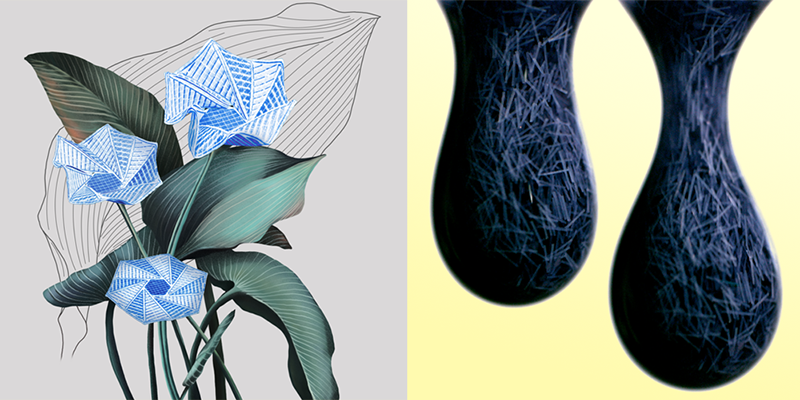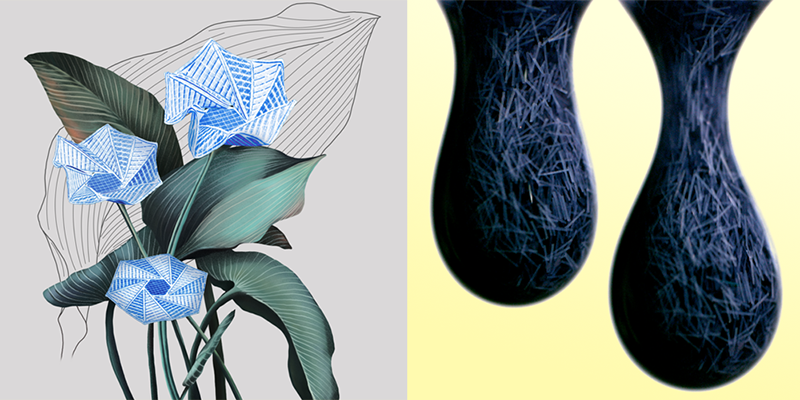Prizes for Videos Featuring Mickey Mouse and Laptop Cables
The APS Division of Soft Matter has announced the winners of the third Gallery of Soft Matter contest at the APS March Meeting in Minneapolis. Here is a rundown of the two videos and three posters that were selected.
The Hardest Ever “Connect the Dots”
This year Disney’s Steamboat Willie cartoon—one of the first screen appearances of Mickey Mouse—entered the public domain, and graduate student Aaron Shih at New York University and colleagues wasted no time in putting the iconic character to scientific use. The researchers used Mickey to demonstrate a new algorithm that can embed information about an image in the statistical properties of a seemingly random pattern of dots.
Embedding an image’s information into a dot pattern isn’t novel, but the algorithm that Shih and colleagues developed applies this idea in a new way. Taking a given image as a target output, their algorithm iteratively adjusts the statistical properties of a group of dots until the image information hidden in that group of dots matches that of the target image. The algorithm can perform this task quickly enough that it can determine the dot patterns required to store a sequence of images from a movie in real time. In their video, the team demonstrates that capability for Steamboat Willie and for the 1896 movie Arrival of a Train at La Ciotat.
Shih and colleagues submitted their video to the Soft Matter Gallery and not an image processing gallery because of the potential application of the algorithm for material design. Finding a dot pattern for a target image is akin to designing a metamaterial with a given diffraction pattern. Shih and colleagues say that their algorithm could allow researchers to imagine disordered metamaterials with functions that go beyond those of the ordered metamaterials that researchers typically build in the lab.
Extracting a Fiber from a Tangle
For their entry, Ishant Tiwari at Georgia Institute of Technology and his colleagues conducted an experiment to better understand the tricky problem of how best to extract a specific cable from a tangle of defunct and obsolete wires. In particular, the team sought to optimize the instinctive strategy of grabbing the desired cable and giving it a good shake.
Tiwari and colleagues experimented both with tangles of cotton threads, which they created by tumbling the threads and a few small weights in a box, and with the fibers of loosely woven gauze. They fixed the target thread or fiber to a piston that oscillated vertically at a fixed rate. The researchers found that they could extract the thread fastest when the oscillation rate maximized the length of time over which the thread and the tangle moved in opposite directions. Tiwari says that the team is in the process of building a version of their “untangler” that could work for wires.
Flowing Fibers, Cannibalizing Droplets, and Robotic Flowers
As well as the two videos, three posters received prizes. Alban Sauret and graduate student Sreeram Rajesh at the University of California, Santa Barbara, presented work on the flow properties of droplets containing agglomerations of fibers. The team’s poster shows images of the fibrous droplets dripping from a syringe and then spreading out on a hydrophilic surface. Such droplets could be used to print fiber-reinforced composite materials with desirable mechanical qualities. Rajesh is currently investigating the factors that influence the final orientations of the fibers, which could affect the properties of the printed material.
In the second winning poster, graduate student Fauzia Wardani of King Abdullah University of Science and Technology in Saudi Arabia and her colleagues presented a photograph of water droplets that had condensed on a chilled, oil-lubricated surface. The oil turned the surface hydrophobic, allowing oil menisci to pull adjacent droplets close enough to merge. Members of the team have shown that as the droplets combine, energy from this merging can propel the droplets across the surface (see Synopsis: Droplets Dance After They Merge). Giving droplets such mobility could make it easier to collect water from dew that forms at night, says Wardini’s colleague Dan Daniel. “No energy is required to condense the droplets, and in the morning we can simply collect the water by tilting the surface.”
Rounding up the winning poster trio is a billboard showing the design for a plant-cell-inspired actuator that was created by Tian Gao of the French National Centre for Scientific Research (CNRS) and his colleagues. Bulliform cells are found in the leaves of monocot plants, such as wheat and rice. The size and shape of these cells depends on their water content; when it changes, it can cause the leaf to curl or uncurl. Gao and colleagues have created 3D-printed analogs of these cells that are actuated by changes in air pressure. They have also incorporated them into engineered flat surfaces that, when activated, can fold and curve into a variety of three-dimensional forms.
–Marric Stephens
Marric Stephens is a Corresponding Editor for Physics Magazine based in Bristol, UK.





